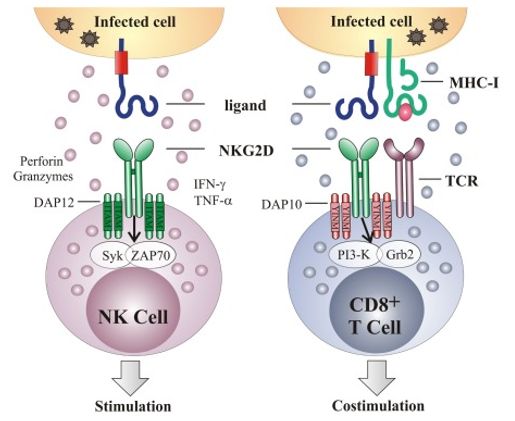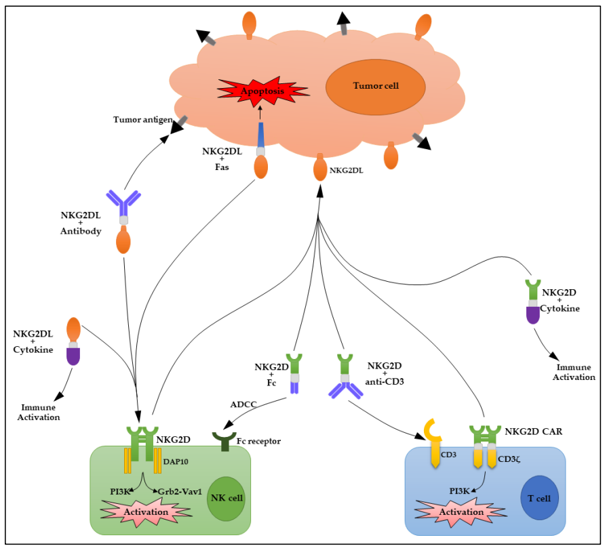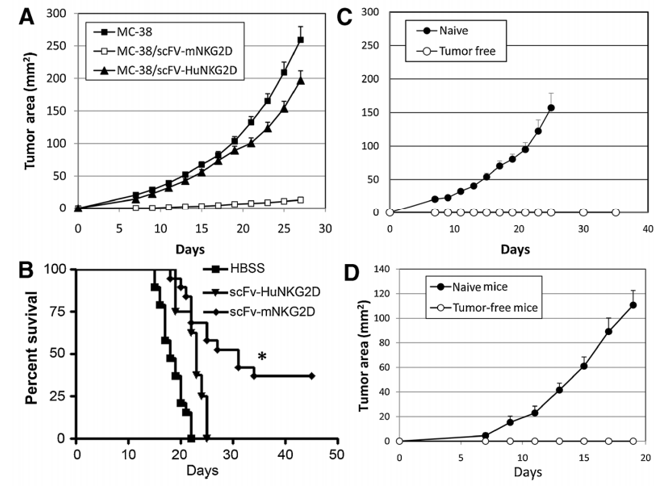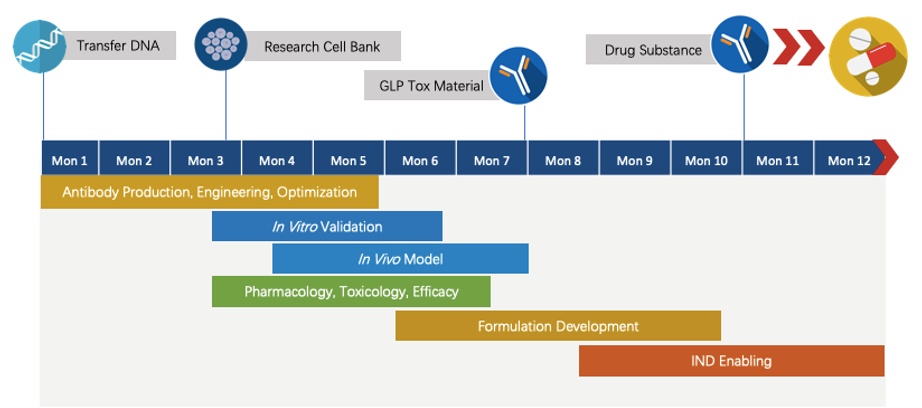Next-IO™ Fusion Proteins of NKG2D Program
As a thriving CRO company, Creative Biolabs has the initiative to acquire, develop and commercialize Next-IO™ programs with a goal to treat cancers. Our fusion proteins of NKG2D program aims to develop fusion proteins that could activate NK cell or T cell immune responses that in turn, attack cancer cells.
NKG2D/NKG2DL Pathway
Natural killer group 2, member D (NKG2D) and NKG2D ligands (NKG2DLs) are critical in cancer immune surveillance. NKG2D is a type-2 activating transmembrane receptor that transmits signals through its adapter molecules - DAP10 or DAP12. Association between NKG2D and DAP10 leads to phosphorylation on YINM motif of DAP10 and recruitment of PI3K/Grb2, while the association with DAP12 results in phosphorylation of Immunoreceptor Tyrosine-based Activation Motif (ITAM) and activation of Syk and Zap70. In NK cells, NKG2D acts as an activation receptor that could trigger NK cell-mediated cytotoxicity and cytokine secretion. In CD8 T cell, NKG2D acts as a co-stimulatory receptor for TCR-mediated CD8+ T cell activation.
 Fig.1 NKG2D acts as an activating and a co-stimulatory receptor to activate NK and CD8+ T cell.1
Fig.1 NKG2D acts as an activating and a co-stimulatory receptor to activate NK and CD8+ T cell.1
Our Fusion Protein of NKG2D Program
A various fusion protein of NKG2D is developed to be therapeutic targets in cancer research. Our proposed program will include NKG2D fusion proteins consists of Fc, monoclonal antibody, cytokine, chimeric antigen receptors.
Antibodies are synthesized with NKG2D to generate fusion proteins. The NKG2D part of the fusion protein can target tumor cells that express NKG2DL, while the Fc portion is to trigger ADCC function against cancer cells.
The anti-CD3 scFv can be used to target CD3 on T cells. When it is synthesized with NKG2D, this fusion can trigger T cells to release anti-tumor cytokines and induce cytotoxicity against NKG2D-ligand positive cancer cells. In vivo studies show improved anti-tumor response and survival curve after the treatment of anti-CD3 scFv-NKG2D fusion proteins.
A variety of cytokines, including IL2, IL15, IL21, will be fused with NKG2D, for the reason that these cytokines can enhance immune cell functions and promote anti-tumor responses.
 Fig.2 Schematic diagram of fusion proteins of NKG2D/NKG2DL in cancer immunotherapy.2
Fig.2 Schematic diagram of fusion proteins of NKG2D/NKG2DL in cancer immunotherapy.2
Published Data
-
NK IFN-γ production is significantly increased upon treatment with NKG2D-Fc constructs in breast cancer models.
-
NK IFN-γ production is significantly increased upon treatment with NKG2D-Fc fusion proteins in primary acute lymphocytic leukemia models.
-
NK IFN-γ production is significantly increased upon treatment with NKG2D-Fc fusion proteins in primary chronic lymphocytic leukemia models.
-
scFv-NKG2D treatment reduces the growth of NKG2D ligand-positive tumors in vivo and memory responses also exist.
 Fig.3 scFv-NKG2D treatment reduces the growth of NKG2D ligand-positive tumors in vivo and memory responses also exist.1
Fig.3 scFv-NKG2D treatment reduces the growth of NKG2D ligand-positive tumors in vivo and memory responses also exist.1
From the data, we learn that the fusion proteins of NKG2D exhibit promising therapeutic benefits for cancer treatments. For any additional assistance, please feel free to reach out to our scientists.
Program Planning and Management
With extensive experience in the discovery and development of therapeutic antibodies, Creative Biolabs is dedicated to providing the top-notch Next-IO™ programs to our clients. We are committed to delivering the finalized program to our partners within about 1.5 years. The accurate timeline will be determined on a case-by-case basis. Here is a draft timeline for your glance.
 Fig.4 The timeline of Next-IOᵀᴹ programs.
Fig.4 The timeline of Next-IOᵀᴹ programs.
Collaboration
Creative Biolabs is excited to offer years of valuable contract research organization (CRO) experience to our programs our partners and achieve more strategic collaborations together. We have accumulated extensive experience during the years of operations in antibody discovery and development. We believe our collaboration will unleash the creative spirit and achieve greater success in immuno-oncology. Creative Biolabs welcomes proposals from clients if you are interested in co-developing programs in immuno-oncology.
If you are interested in the collaborations, please don’t hesitate to contact us to learn more.
References
-
Zhang, Tong, and Charles L Sentman. "Cancer immunotherapy using a bispecific NK receptor fusion protein that engages both T cells and tumor cells." Cancer research. 71,6 (2011): 2066-76.
-
Ding, Hui et al. "Fusion proteins of NKG2D/NKG2DL in cancer immunotherapy." International journal of molecular sciences. (2018) 19,1 177.
-
Slavuljica, Irena et al. "Manipulation of NKG2D ligands by cytomegaloviruses: impact on innate and adaptive immune response." Frontiers in immunology. (2011) 2 85.
For Research Use Only | Not For Clinical Use


 Fig.1 NKG2D acts as an activating and a co-stimulatory receptor to activate NK and CD8+ T cell.1
Fig.1 NKG2D acts as an activating and a co-stimulatory receptor to activate NK and CD8+ T cell.1
 Fig.2 Schematic diagram of fusion proteins of NKG2D/NKG2DL in cancer immunotherapy.2
Fig.2 Schematic diagram of fusion proteins of NKG2D/NKG2DL in cancer immunotherapy.2
 Fig.3 scFv-NKG2D treatment reduces the growth of NKG2D ligand-positive tumors in vivo and memory responses also exist.1
Fig.3 scFv-NKG2D treatment reduces the growth of NKG2D ligand-positive tumors in vivo and memory responses also exist.1
 Fig.4 The timeline of Next-IOᵀᴹ programs.
Fig.4 The timeline of Next-IOᵀᴹ programs.
 Download our brochure
Download our brochure

